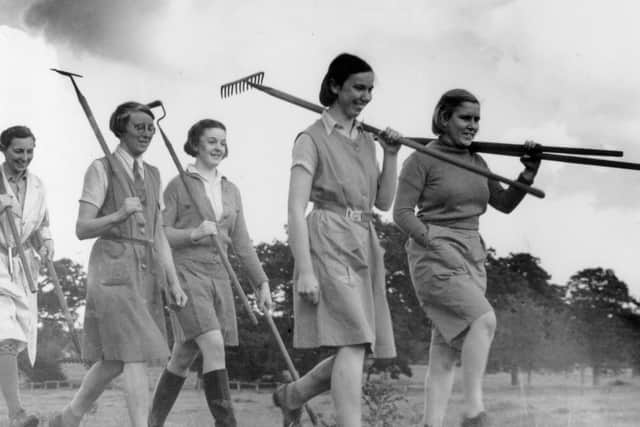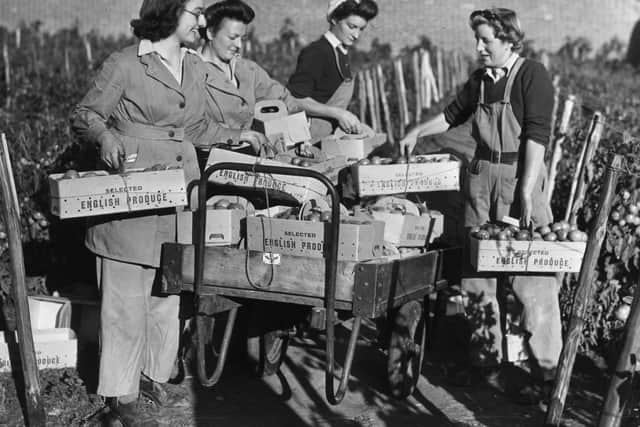Women praised for work as wartime came to a close - The Week That Was in 1945
This article contains affiliate links. We may earn a small commission on items purchased through this article, but that does not affect our editorial judgement.
Although the country still awaited the ending of the conflict in Japan and the Pacific, VE Day signalled to families that they could at last look to the future.
Those on the home front had weathered more than 40,000 civilian deaths in the blitz, rationing (which would continue until 1954), the stress of fearing for family members in active service - and tens of thousands of actual losses.
Advertisement
Hide AdAdvertisement
Hide AdWar time had also been a time of tremendously hard work for the women of Britain. They too had answered a call to arms.


In 1939 just over five million women were in work, mostly employed as clerical staff, nurses, shop assistants or in domestic work in the homes of the wealthy.
Nicholson says: “Never before had the boundaries between home front and front line been so blurred…”
From housewives and mothers to factory workers and farm hands, healthy women under 40 across the country became pivotal to the war effort.
Advertisement
Hide AdAdvertisement
Hide Ad

But later, once the parties were over, those women who had taken over jobs in munitions factories or chemical and engineering industries, driven trucks and buses, dug for victory in the Women’s Land Army or cracked codes in the Special Operations Executive were left wondering ‘what now?’.
Hundreds of thousands of them had worn the uniform of the Auxiliary Territorial Service (ATS), Women’s Auxiliary Air Force (WAAF) and Women’s Royal Naval Service (WRNS), supporting those at the front. Women were visible as never before.
When it was all over, the Government praised women’s wartime work. Their importance to the Second World War even has its own monument close to the Cenotaph - although it was not installed until 2005.
Once silence fell over Britain, though, had society changed and had the experience of life outside the domestic sphere affected women’s lives in a lasting sense? Not immediately.
Advertisement
Hide AdAdvertisement
Hide AdAs the men returned and resumed what were always considered to be ‘their’ roles, wartime nurseries closed and women were encouraged back into the home to raise the next generation of workers (boys).
As Virginia Nicholson says: “Deep down, women knew they had exploded the inequality myth, but in practice they were shattered and exhausted. Many wanted to be feminine again, to bring up their babies and rekindle the home fires.”
But some who had relished the discovery of life beyond domesticity - the camaraderie, the sense of achievement, the independent earnings (even though they were paid less than men) - found other sources of childcare and worked alongside men in factories.
These few were joined by some of the women who had divorced soon after the war. The years 1946-7 saw an unprecedented spike in the divorce rate to 46 per cent - largely due to hasty wartime marriages followed later by the cold realisation of incompatibility.
Advertisement
Hide AdAdvertisement
Hide AdTrue change came slowly, through the process of mothers telling daughters about their wartime exploits and how they their world had shrunk again after 1945.
But it’s crucial to recognise that their experiences did provide context to the feminist campaigns of the 1960s and 70s to achieve gender equality both socially and in the workplace. On so many levels their importance must never be forgotten.
For more stories from the YP Magazine and The Yorkshire Post features team, visit our Facebook page.
Editor’s note: first and foremost - and rarely have I written down these words with more sincerity - I hope this finds you well.
Advertisement
Hide AdAdvertisement
Hide AdAlmost certainly you are here because you value the quality and the integrity of the journalism produced by The Yorkshire Post’s journalists - almost all of which live alongside you in Yorkshire, spending the wages they earn with Yorkshire businesses - who last year took this title to the industry watchdog’s Most Trusted Newspaper in Britain accolade.
And that is why I must make an urgent request of you: as advertising revenue declines, your support becomes evermore crucial to the maintenance of the journalistic standards expected of The Yorkshire Post. If you can, safely, please buy a paper or take up a subscription. We want to continue to make you proud of Yorkshire’s National Newspaper but we are going to need your help.
Postal subscription copies can be ordered by calling 0330 4030066 or by emailing [email protected]. Vouchers, to be exchanged at retail sales outlets - our newsagents need you, too - can be subscribed to by contacting subscriptions on 0330 1235950 or by visiting www.localsubsplus.co.uk where you should select The Yorkshire Post from the list of titles available.
If you want to help right now, download our tablet app from the App / Play Stores. Every contribution you make helps to provide this county with the best regional journalism in the country.
Sincerely. Thank you.
James Mitchinson
Editor